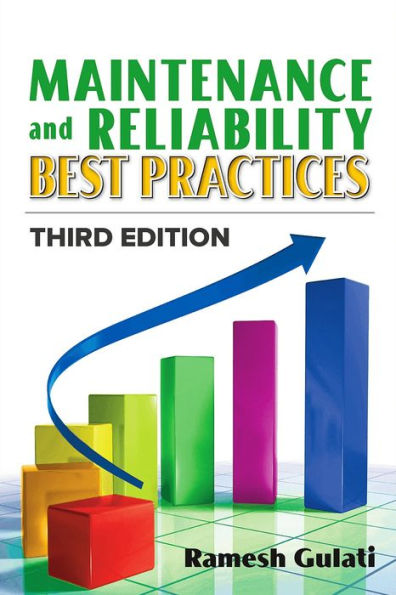Now in 2-colors to clearly identify main ideas and emphasize important data in illustrations, the book also includes additional self-assessment questions in each chapter. The entire work has been updated to reflect the latest developments in technology and thinking, with innovative material related to leadership, change management, ISO standards, maintenance optimization, and communication, while sticking to the practical, common-sense approach that led readers to call it “a great book for developing a road map to reliability,” and “the perfect guide for setting up an effective maintenance program.”
For anyone in the fields of engineering, purchasing, finance, maintenance, reliability, or production, and especially for those preparing to sit for a professional maintenance and reliability certification, there’s simply no better tool or resource than renowned Ramesh Gulati’s Maintenance and Reliability Best Practices, 3e.
Features
- 40% additional questions throughout the book, making it easier for those preparing to sit for a professional maintenance and reliability exam to learn and study pertinent topics.
- New chapter on standards, with particular focus on ISO 55000.
- Discussion of new and future trends, such as Industry 4.0, Maintenance 4.0, IIOT, and their impact on productivity.
- An affiliated Workbook is available for sale separately (978-0-8311-3648-2).
Reviews
“I have been a student of M&R for many years, though always in non-technical positions as a professional marketer for products and services companies in the industrial space. I realized whenever I studied Maintenance and Reliability Best Practices in preparation for the CMRP exam, that I was on the right track. Thank you for allowing me to successfully pass the exam as a result of your book on top of the nearly eight years I’ve been in the industry. I appreciate you very much. I just received notice that I passed the CMRP from The Society for Maintenance and Reliability Professionals! Thank you for the opportunity to learn from you and for your encouragement. I’m very proud to be a CMRP!”—Amy Campbell, CMRP
“All you need to do is open this book to any page, and the powerful wisdom of Ramesh Gulati is readily available! Make sure you get the new third edition loaded with bonus knowledge and experience.”— Terrence O’Hanlon
“I enjoyed your book tremendously and after reading it several times (along with 20 years of maintenance experience), I was able to take and pass the CMRP certification. Thank you!”—Steve J. Firko, CMRP
Now in 2-colors to clearly identify main ideas and emphasize important data in illustrations, the book also includes additional self-assessment questions in each chapter. The entire work has been updated to reflect the latest developments in technology and thinking, with innovative material related to leadership, change management, ISO standards, maintenance optimization, and communication, while sticking to the practical, common-sense approach that led readers to call it “a great book for developing a road map to reliability,” and “the perfect guide for setting up an effective maintenance program.”
For anyone in the fields of engineering, purchasing, finance, maintenance, reliability, or production, and especially for those preparing to sit for a professional maintenance and reliability certification, there’s simply no better tool or resource than renowned Ramesh Gulati’s Maintenance and Reliability Best Practices, 3e.
Features
- 40% additional questions throughout the book, making it easier for those preparing to sit for a professional maintenance and reliability exam to learn and study pertinent topics.
- New chapter on standards, with particular focus on ISO 55000.
- Discussion of new and future trends, such as Industry 4.0, Maintenance 4.0, IIOT, and their impact on productivity.
- An affiliated Workbook is available for sale separately (978-0-8311-3648-2).
Reviews
“I have been a student of M&R for many years, though always in non-technical positions as a professional marketer for products and services companies in the industrial space. I realized whenever I studied Maintenance and Reliability Best Practices in preparation for the CMRP exam, that I was on the right track. Thank you for allowing me to successfully pass the exam as a result of your book on top of the nearly eight years I’ve been in the industry. I appreciate you very much. I just received notice that I passed the CMRP from The Society for Maintenance and Reliability Professionals! Thank you for the opportunity to learn from you and for your encouragement. I’m very proud to be a CMRP!”—Amy Campbell, CMRP
“All you need to do is open this book to any page, and the powerful wisdom of Ramesh Gulati is readily available! Make sure you get the new third edition loaded with bonus knowledge and experience.”— Terrence O’Hanlon
“I enjoyed your book tremendously and after reading it several times (along with 20 years of maintenance experience), I was able to take and pass the CMRP certification. Thank you!”—Steve J. Firko, CMRP

Maintenance and Reliability Best Practices
768
Maintenance and Reliability Best Practices
768Hardcover(Third Edition)

Product Details
| ISBN-13: | 9780831136475 |
|---|---|
| Publisher: | Industrial Press, Inc. |
| Publication date: | 09/14/2020 |
| Edition description: | Third Edition |
| Pages: | 768 |
| Sales rank: | 233,206 |
| Product dimensions: | 6.00(w) x 9.00(h) x 1.75(d) |
| Age Range: | 18 Years |
